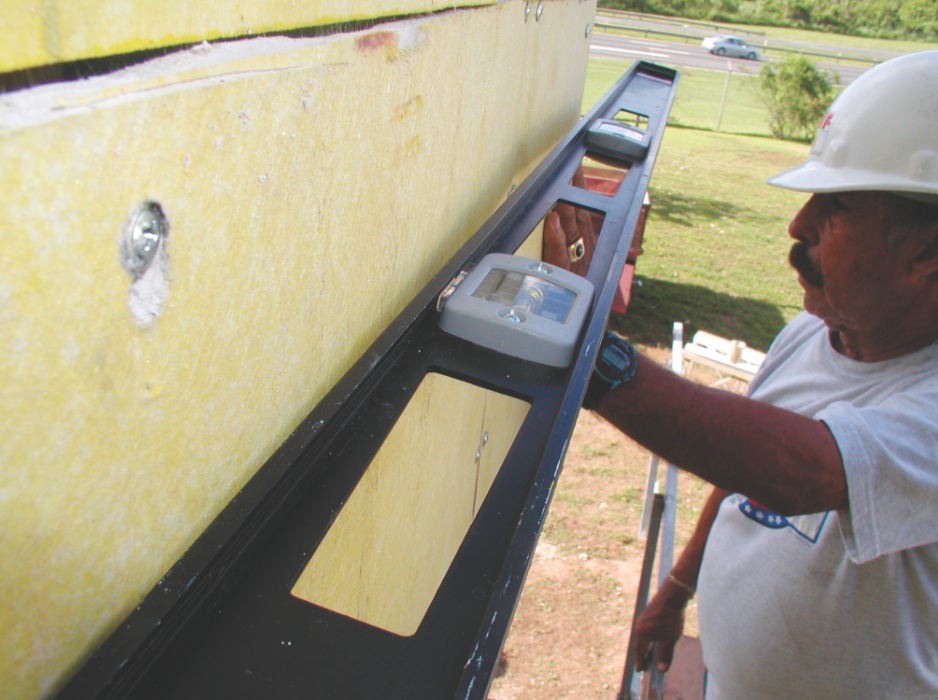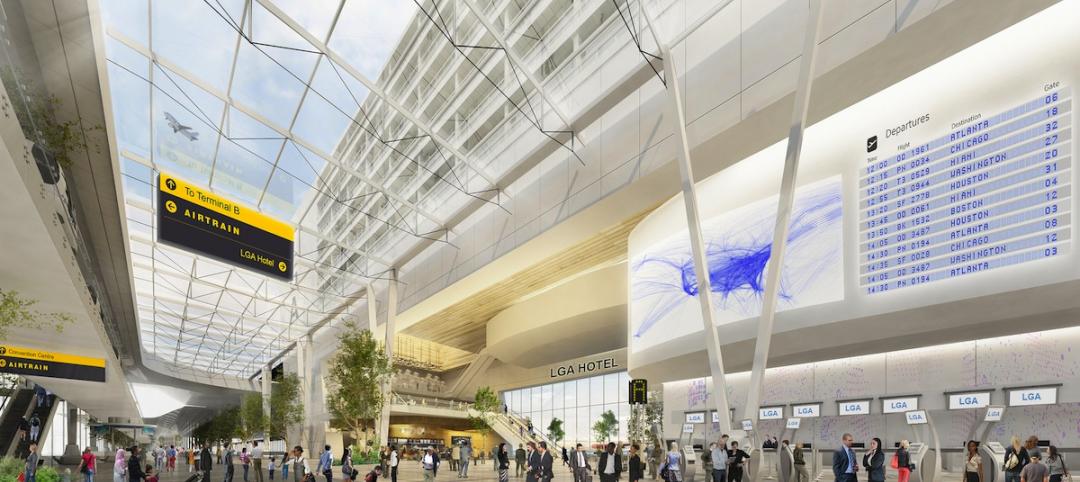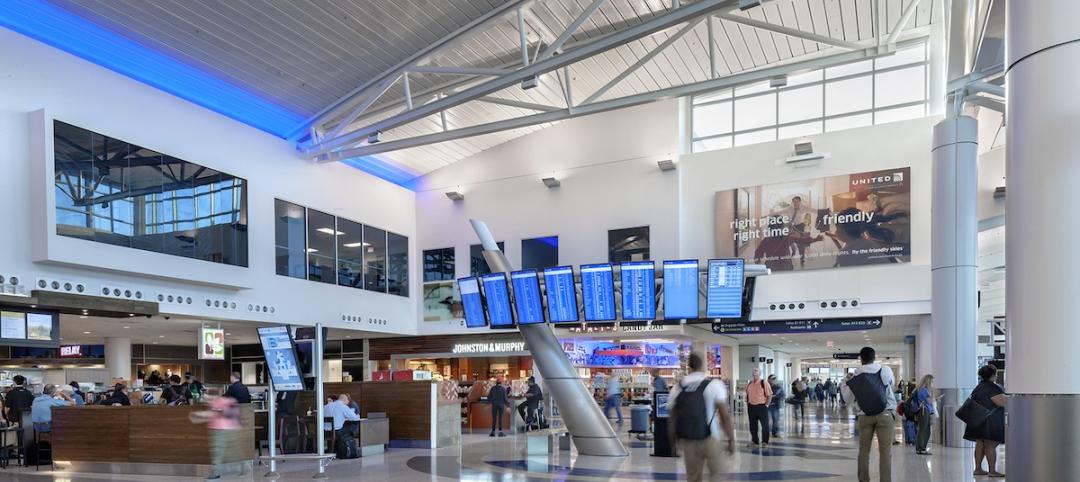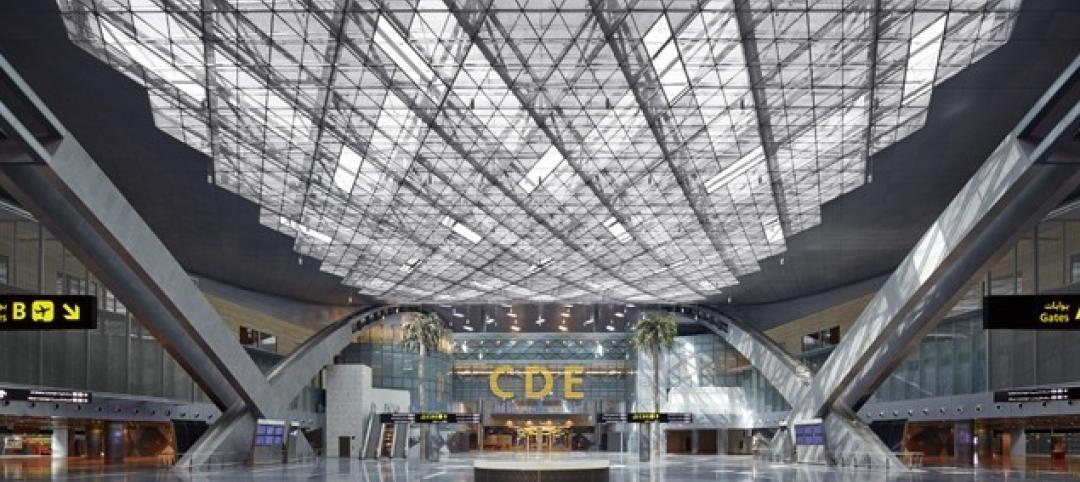Editor's note: This article was originally published as part of an AIA/CES Discovery course: "EIFS: How to succeed with exterior insulation and finish systems." Take this free course at BDCUniversity.com.
Originally, EIFS was designed as a “perfect barrier” system; that is, one which provides waterproofing protection at the exterior face of the cladding. The idea of barrier cladding assemblies is to create a face-sealed façade that repels moisture to keep the building dry.
Unfortunately, barrier systems are rarely perfect. All it takes to compromise water tightness is a small breach in the exterior finish, such as a crack due to expansion, sealant failure at joints, or impact damage. Once water finds its way into a barrier system, it usually can’t find its way back out. Water trapped in the wall can lead to leaks, wet substrate, mold, deterioration of building components, and, eventually, collapse of the weakened cladding.
Any number of deficiencies can lead to EIFS failure. The major culprits are poor workmanship, damp climate, impact damage, building movement, and incompatible or unsound substrate.
How to avoid poor workmanship
There are numerous opportunities for installation errors and poor workmanship to ruin an EIFS job.
Sealant joints are a major source of problems with EIFS cladding. Incorrect selection or application of sealants, or missing sealants, provides an easy path for water entry and premature deterioration. Inappropriate sealant may even lead to cohesive failure of the EIFS finish coat. Sealant erroneously applied to the finish coat, rather than to the mesh-reinforced base coat, is a common source of problems.
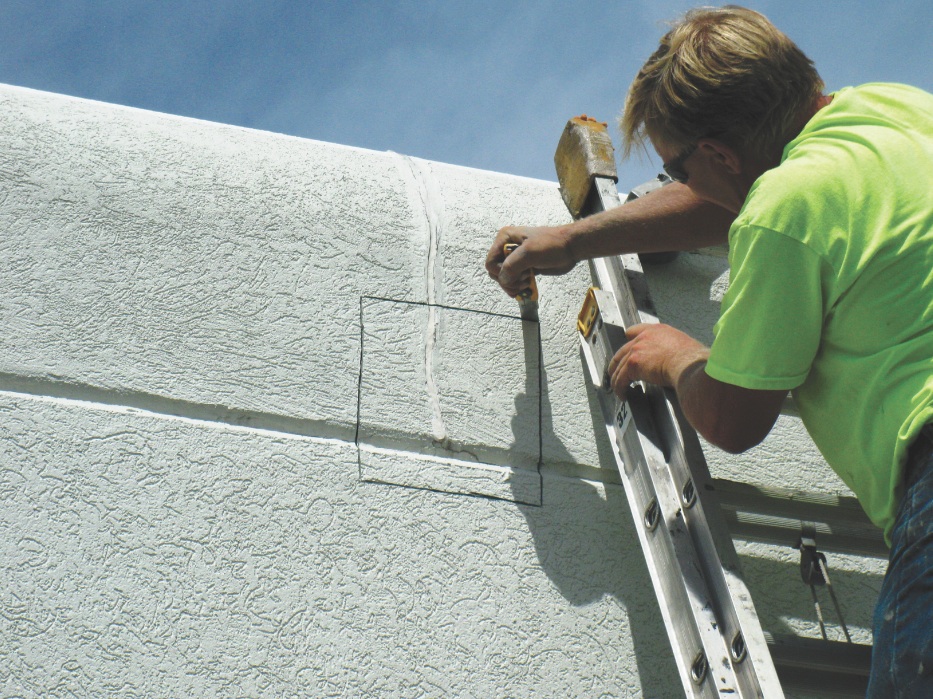
Invasive probes, including test cuts of existing EIFS cladding, can uncover hidden deterioration conditions. A seemingly impervious exterior may mask wet or crumbling wall board beneath the surface. Image courtesy Hoffmann Architects
Flashings that are incorrectly installed or missing provide a conduit for water infiltration. Door and window openings should incorporate flashings to direct water away from headers and sills. At roof/wall intersections, drip-edge flashings should be installed to channel rainwater away from the wall face.
Base coat thicknesses that don’t meet the manufacturer’s guidelines are another source of trouble for EIFS façades. A base coat that is too thin provides insufficient waterproofing protection, whereas a base coat that is too thick may lead to cracking.
Reinforcing mesh that reads through at joint edges or terminations can indicate inadequate coating thickness. Alternatively, the mesh may have been insufficiently embedded in the base coat. Continuing the mesh-reinforced base coat around to the back of the insulation board, known as “backwrapping,” is critical to providing continuous waterproofing protection at edges, penetrations, and terminations. Where appropriate, factory-formed track may be used at foundation terminations instead of backwrapping.
Aesthetic joints (V-grooves) that align with insulation board joints can lead to cracks as the building moves. Mesh-reinforced base coat should be continuous at recessed features.
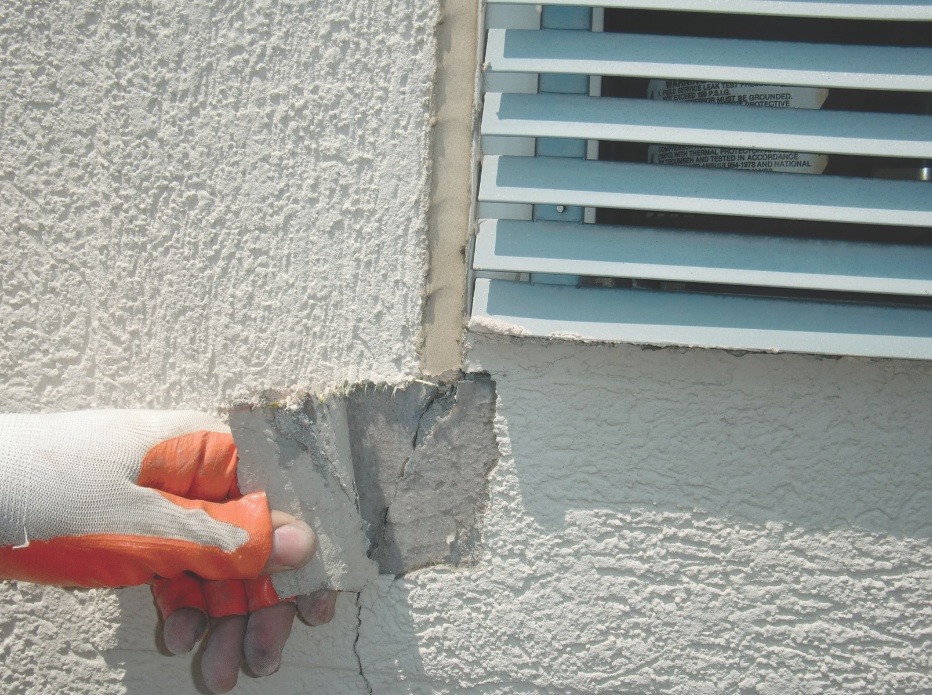
At the corners of windows, doors, and louvers, EIFS design should incorporate butterfly reinforcement, with diagonal pieces of mesh that provide additional reinforcing and prevent cracking. Image courtesy Hoffmann Architects
Window and door corners, like aesthetic joints, should not align with insulation board joints. “Butterfly” reinforcement, whereby rectangular pieces of reinforcing mesh are laid diagonally at the corners of windows, doorways, and other openings, is important to preventing cracking.
Expansion joints are too often neglected in EIFS construction, but they are no less critical here than with other types of cladding. Expansion joints should be used:
• At changes in building height
• At areas of anticipated movement
• At floor lines (particularly for wood frame construction)
• Where the substrate changes
• Where prefabricated panels abut one another
• At intersections with dissimilar materials
• Where expansion joints exist in the substrate or supporting construction
Insulation board should not bridge expansion joints in masonry or concrete substrates. Instead, an expansion joint should be created in the EIFS insulation over the underlying joint. Insulation board should meet the manufacturer’s recommended minimum thickness (usually 3/4 inch), even at aesthetic joints and recesses. Vertical joints in the insulation should be staggered in a running bond pattern in successive courses, with boards abutted tightly to one another.
Gaps between boards should never be filled with base coat or adhesive, which can cause cracking; rather, slivers of insulation may be wedged between boards where needed. Selecting a board adhesive that is compatible with both the insulation and the substrate is critical to successful performance of EIFS.
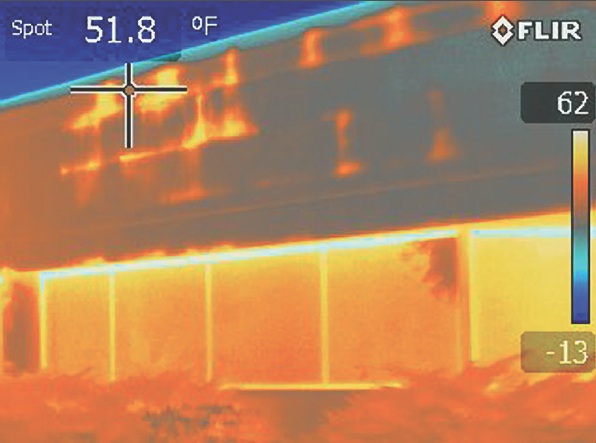
This infrared thermographic scan reveals trapped moisture at insulation board joints. Image courtesy Hoffmann Architects
Deal with climate factors
A humid climate with limited drying potential can devastate some EIFS assemblies, particularly when the rate of wetting exceeds the rate of drying. Poor design and installation exacerbate this problem by providing avenues for water to penetrate the cladding, while the humidity prevents damp walls from drying out.
The amount of rain deposited on a wall is dependent not only on climate, but also on the architecture and siting of the structure. Building height, overhangs, exposure, and façade details all affect the path of rainfall, channeling more or less moisture toward the cladding.
Cold climates may also lead to premature failure, particularly when EIFS coatings are applied at temperatures below the manufacturer’s design range.
Guard EIFS against impact
EIFS assemblies consist of a thin, brittle coating over a soft substrate and are easily damaged by impact. Holes, dents, or scrapes can lead to water infiltration, so it’s prudent to provide extra reinforcement at susceptible locations.
Areas needing impact protection should use heavy-duty mesh, usually 12 to 20 ounces, rather than standard 4.5-ounce mesh. For outside corners, the design professional may specify a heavier corner mesh to guard against excess wear and damage. Intricate decorative elements require a lightweight, flexible detail mesh, which conforms to fine contours and ornamental details while still providing some measure of impact protection.
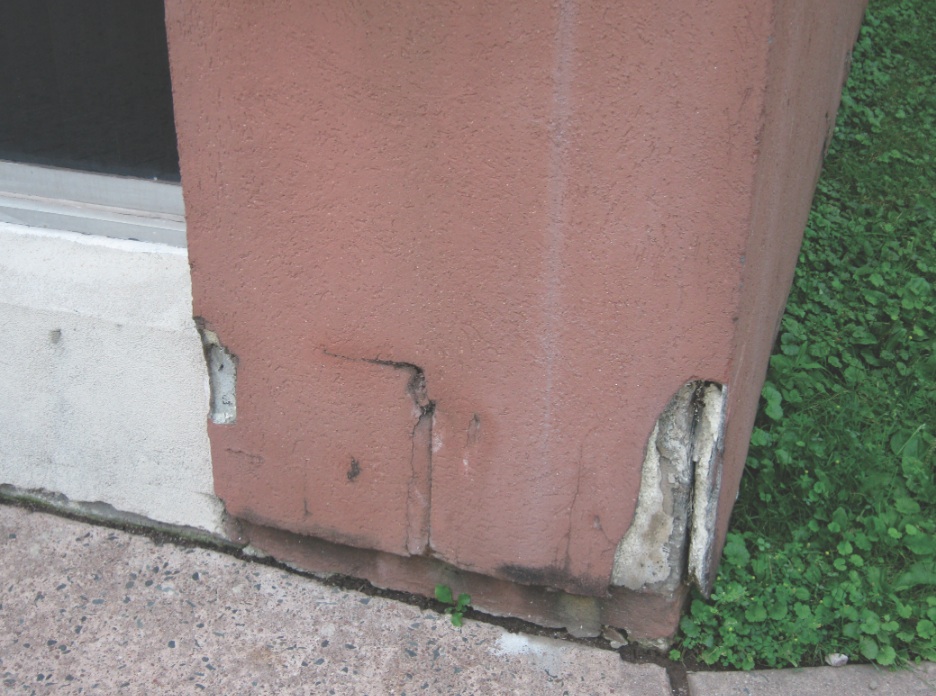
Impact damage that is not repaired promptly provides a pathway for leaks. Image courtesy Hoffmann Architects
Account for building movement
Wood substrates tend to exhibit cross-grain shrinking, along with expansion and contraction from changes in humidity. For concrete, movement tends to come in the form of frame shortening, whereby concrete deforms over time due to shrinkage and creep. Steel structures are not immune to the effects of building movement, particularly at long-span beams, where transverse forces are greatest and deflection more likely. To prevent irregular cracking, sufficient provision for expansion and control joints should be part of your design.
Avoid use of incompatible or unsound substrate
Poor quality control in the production of oriented strand board (OSB), a common substrate for EIFS, has raised concerns about premature failure, so use a reputable manufacturer with a good track record. Gypsum board, often used with EIFS, tends to exhibit problems with moisture absorption, so avoid using it in damp or humid climates. Even if the substrate is of high quality and suitable for the building location, failure to correctly specify or install substrate attachment may lead to premature cladding problems.
Related Stories
Airports | Jul 28, 2015
Plans to make over New York’s aging LaGuardia Airport are revealed
The complete redesign, devised by a panel of experts, would unify terminals, relieve ground traffic congestion, and install state-of-the-art amenities.
Airports | Jul 22, 2015
MUST SEE: JFK airport taps Gensler to design terminal for animals
Pets can enjoy luxurious spa and grooming services before being transported directly to their flight from the terminal.
Airports | Jul 1, 2015
FIRST LOOK: JetBlue opens sprawling green rooftop at JFK International Airport
The 4,046-sf rooftop includes landscaped green spaces, seating for 50 people, 400-sf children’s play area, and a 400-sf dog-walk area.
Sponsored | Airports | Jun 5, 2015
Exposed glulam framework offers quiet complement to Jackson Hole airport’s mountain backdrop
A three-phase expansion and renovation, which began in 2009, nearly doubled the size of the aviation hub; the only one located in a national park
Airports | Apr 21, 2015
Trends driving airport construction
Upgrades to aviation infrastructure have not kept pace with the increase in airport traffic or even at a level sufficient to accommodate the life cycle of our many dated terminal facilities. Until now.
Airports | Feb 6, 2015
Zaha Hadid-designed terminal in Beijing will be world’s largest
The terminal will accommodate 45 million passengers per year, and will be a hub for both air and rail travel.
| Jan 2, 2015
Construction put in place enjoyed healthy gains in 2014
Construction consultant FMI foresees—with some caveats—continuing growth in the office, lodging, and manufacturing sectors. But funding uncertainties raise red flags in education and healthcare.
BIM and Information Technology | Dec 28, 2014
The Big Data revolution: How data-driven design is transforming project planning
There are literally hundreds of applications for deep analytics in planning and design projects, not to mention the many benefits for construction teams, building owners, and facility managers. We profile some early successful applications.
| Dec 28, 2014
AIA course: Enhancing interior comfort while improving overall building efficacy
Providing more comfortable conditions to building occupants has become a top priority in today’s interior designs. This course is worth 1.0 AIA LU/HSW.
| Dec 28, 2014
The future of airport terminal design: destination status, five-star amenities, stress-free travel
Taking a cue from the hospitality industry, airport executives are seeking to make their facilities feel more like destinations, writes HOK's Richard Gammon.


